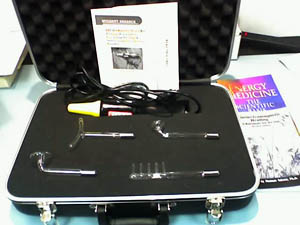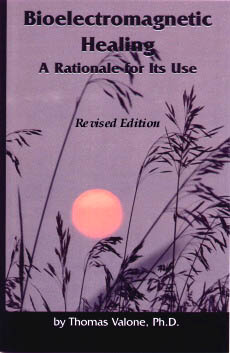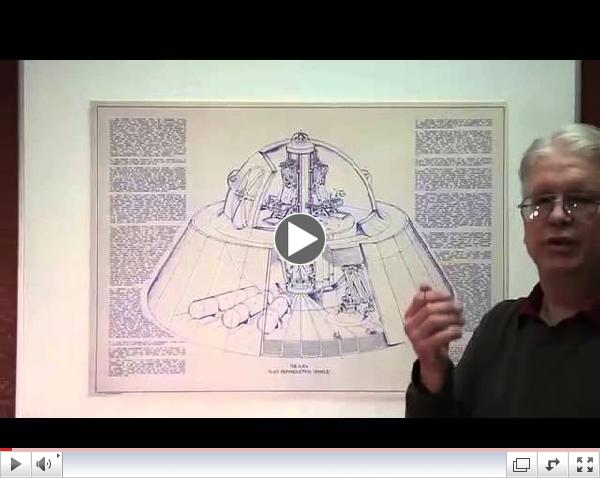|
|
|
Greetings!
If
you are in the DC area, this Sunday, March 30th will
be a public appearance day for me and the IRI booth at the Natural Living
Expo in Bethesda MD Marriott hotel and conference
center where we will be exhibiting the www.BioenergyDevice.org electrotherapy
equipment.
Our
Story #1 is perhaps the most amazing and revealing
documentary called "Zero-Point" that has
ever been made concerning the famous hovering
electrogravitics craft from Norton AFB called the
"Fluxliner". The story has been included for ten years in
the last chapter of the 2004 book, Electrogravitics
II: Validating Reports on a New Propulsion Methodology and
now much more corroborating evidence is finally presented by military
artist Mark McCandlish and several others for the first time. Unfortunately,
the young filmmaker James Allen just died just a couple of months ago
under mysterious circumstances and the self-ordered autopsy (online)
reveals thorium and uranium in his system, so the commercial video
was simply uploaded to YouTube as a giveaway. As a related item, the
hardback edited volume, Gravitoelectromagnetic
Theories and Their Applications to Advanced Science and Technology with
contributed papers by Drs. Musha, Pinheiro, and Valone is now
available from Nova Publishers. It also contains two (2) chapters on
electrogravitics.
Story
#2 explains how hydrogen filled airships will be the
next emerging drones to fly for weeks at a time at high altitude,
with military and civilian groups competing for the product.
Story
#3 is worth celebrating about. It reviews the long-awaited opening of
the Ivanpah Solar Electric Generating System in California's Mojave
Desert. With almost a half gigawatt of electric power, it
is easily the largest solar thermal power plant in the world. The
huge savings in carbon emissions is also very impressive.
With
great power comes great responsibility. Our Story #4 certainly
beckons that concern as civilian and military applications of high
power lasers collide. The important high energy application that
should be on everyone's mind after the last asteroid impact in Russia
is how to protect the planet from large space invader rocks, as the
United Nations now has agreed to do. http://www.nationaljournal.com/politics/united-nations-takes-first-big-step-in-defending-earth-from-killer-asteroids-20131028.
Nudging them while they are still far away from earth with a
high power laser that finally pulses its way through the atmosphere
could be our best bet to prevent a tsumani (which is very likely even
from small asteroid impacts in our 2/3 ocean planet when they don't
incinerate completely in the atmosphere) or citywide devastation.
Hopefully this advanced energy breakthrough will find its way into
defensive modes that provide more security rather than more weaponry.
Story #5 is a beautiful example of engineering plants
for enhanced energy output, including electrical energy, biosensing,
and enhanced photosynthesis, with the help of nanotubes and
nanoparticles.
Sincerely,
Thomas
Valone, PhD, PE.
Editor
|
|
|


PREMIER
JUNIOR 500
Electric
Medicine Device

The
Best book on Electric Medicine
|
|
|
1)"Zero-Point" Documentary on
Electrogravitics Fluxliner
|
Integrity Research
Institute Press Release March 23, 2014
 Bolide Motion Pictures in association with the
Centre for Jim Gladman Studies released a documentary about a
military vehicle illustrator, quantum physics and possibly
reverse-engineered alien propulsion technology, currently unfinished.
The first five minutes are an introduction and overview of the
Disclosure Project from 2000 and the rest is a full length interview
and summary of the pulsed electrokinetics hovercraft that was on
display at an Air Force Base in 1988. It appears from the performance
capabilities of each craft that "inertial shielding" is
also involved in the design of the hull of the craft to account for
its abilities.Mark was a contributor to the second book on Electrogravitics. It
reviews the craft seen in the last chapter of the book, with Mark's
contributed article on the craft, which was on display at Norton
AFB in 1988, which is powered by pulsed electrokinetics that
is explained by Prof. Jefimenko's electrokinetic equation: Bolide Motion Pictures in association with the
Centre for Jim Gladman Studies released a documentary about a
military vehicle illustrator, quantum physics and possibly
reverse-engineered alien propulsion technology, currently unfinished.
The first five minutes are an introduction and overview of the
Disclosure Project from 2000 and the rest is a full length interview
and summary of the pulsed electrokinetics hovercraft that was on
display at an Air Force Base in 1988. It appears from the performance
capabilities of each craft that "inertial shielding" is
also involved in the design of the hull of the craft to account for
its abilities.Mark was a contributor to the second book on Electrogravitics. It
reviews the craft seen in the last chapter of the book, with Mark's
contributed article on the craft, which was on display at Norton
AFB in 1988, which is powered by pulsed electrokinetics that
is explained by Prof. Jefimenko's electrokinetic equation:
"Here
is the rough cut of the documentary about my research into
the anti-gravity technology the U.S. military back-engineered
from UFO crash retrievals". Mark McCandlish
|

|
|
ZP finalCut full
|
Zero-Point:
the Story of Mark McCandlish and the Flux Liner is the project
of James Allen, a SCAD MFA graduate in Film and TV.
"It's
an unfinished project, with some rough edges," says the
filmmaker. "But the story is all there, the main structure is there."
With a little more funding, it is sure to go mainstream! (See below
if you would like to help fund the project.)
Here
are the basics of the film ZERO POINT:
The
story line is absolutely compelling and centers on the story of Mark
McCandlish, a well-regarded aerospace illustrator. Some of Mark's
background incudes his involvement with U.S. Air Force and Air
National Guard fighters, such as the F-15 Eagle and the F-16 Fighting
Falcon. In 1986, Mr. McCandlish became aware that the U.S. military
was in possession of some extraordinary technologies, and he began to
pursue his own private research into where it came from and how it
works. Needless to say , McCandlish's research led to many strange
events and encounters.
|

|
|
Director of the Zero Point Film, James Allen.
|
"Mark
was a very successful illustrator in the aeronautics and defense
industry in the '80s - he worked for all kinds of major
contractors," says Director, James Allen.
McCandlish
and a friend, a fellow aviation buff, were set to go to an air show
at an Air Force base in California. But at the last minute McCandlish
got a lucrative freelance gig he couldn't turn down.
"His
friend got back and said he'd met some high-level guy - like some
assistant secretary of defense or something - and ended up getting
into a top secret air show where he saw a bunch of prototype
stuff," Allen says. "The friend said 'I think I saw
something I'm not supposed to see' - stealth technology and some type
of manmade antigravity craft. We're talking about potentially faster
than light."
The
UFO angle is set up from the opening frames, as the film reveals a
presentation from the 2001 at the National Press Club in
which a number of very high-ranking, highly-credentialed people talk
openly about their experience with extraterrestrial presences.
The
idea is that the craft McCandlish's friend saw - the friend has since
refused to be quoted in the film, though he doesn't deny his account
- was possibly "reverse-engineered" from an
extraterrestrial craft.
Flux
Liner also known as an ARV ; Alien Reproduction Vehicle
In
this case, the so-called "Flux Liner, or "Alien
Reproduction Vehicle," as it was also labeled, really says it
all.
Listen
to this amazing 90 minute interview as Mark McCandlish and Director
James Allen discuss the film
|

|
|
ZP finalCut full
|
back to table of contents
|
2) How
Airships Are Set to Revolutionize Science
|
http://www.technologyreview.com/view/525331/how-airships-are-set-to-revolutionize-science/
The
Naval Air Engineering Station in Lakehurst New Jersey must be one of
the most famous airfields in the world. If you've ever watched the
extraordinary footage of the German passenger
airship Hindenburg catching fire as it attempted to moor, you'll
have seen Lakehurst. That's where the disaster took place.

Despite
its notorious past, Lakehurst is still a center of airship
engineering and technology. In 2012, it was home to the Long
Endurance Multi-Intelligence Vehicle, an airship designed and built
for the U.S. military to use for surveillance purposes over
Afghanistan.
The
vehicle is colossal-91 meters long, 34 meters wide, and 26 meters
high, about the size of a 30 story office block lying on its side.
And it is designed to fly uncrewed at about 10 kilometers for up to
three weeks at a time. (Last year, the program was canceled and the
airship sold back to the British contractor that built it, which now
intends to fly it commercially.)
This
ambitious program and a few others like it mostly funded by the U.S.
military, have attracted some jealous glances from scientists. The
ability to fly at 20 kilometers or more for extended periods of time
could be hugely useful.
Fitted
with cameras that scan the ground, sensors that monitor the
atmosphere or telescopes that point to the stars, these observatories
could revolutionize the kind of data researchers are able to gather
about the universe.
Today,
Sarah Miller and few pals have prepared a report for the Keck
Institute of Space Studies in Pasadena suggesting that scientists
have unnecessarily ignored the advantages of airships and that the
time is right for a new era of science based on this capability.
The
problem, of course, is that airships capable of these missions have
not yet been built. Most of the well-funded development has come from
the military for long duration surveillance missions. But with the
end of the wars in Iraq and Afghanistan and the downsizing of the
U.S. military machine, this funding has dried up.
But
Miller and co have a suggestion. They say that innovation in this
area could be stimulated by setting up a prize for the development of
a next-generation airship, just as the X-Prize stimulated interest in
reusable rocket flights. The goal, they say, should be to build a
maneuverable, stationed-keeping airship that can stay aloft at an
altitude of more than 20 km from least 20 hours while carrying a
science payload of a least 20 kg.
That's
a significant challenge. One problem will be carrying or generating
the power required to propel the airship. This increases with the
cube of its airspeed and so will be the biggest drain on the
vehicle's resources.
Another
challenge is to handle the thermal loads at this altitude, where
temperatures can vary by as much as 50 °C and where there is little
air to carry heat away.
But
none of these problems look like showstoppers. Given the right kind
of incentives, it should be possible to put one of these things in
the air in the very near future, perhaps based on the technology
developed for vehicles like the Long Endurance Multi-Intelligence
Vehicle.
All
that's needed is a sponsor willing to cough up a few million dollars
for a prize. Anybody with a few bucks to spare?
Ref: arxiv.org/abs/1402.6706 :
AIRSHIPS : A New Horizon for Science
back to table of
contents
|
3) The Largest
Solar Power Electricity Generator Opens In California
|
Alan
Taylor, InFocus, Mar 4, 2014 |
http://www.theatlantic.com/infocus/2014/03/the-ivanpah-solar-electric-generating-system/100692/
Ed.
Note: This amazing electrical plant, largest of its kind in the
world, just opened in February, 2014 and saves about a half million
tons of CO2 from going into the atmosphere besides generating almost
a half gigawatt of electricity. - TV

In
California's Mojave Desert, about 40 miles southwest of Las Vegas (Google map), lies a five-square-mile
solar thermal power project called the Ivanpah Solar Electric
Generating System (SEGS). The $2.2 billion facility consists of three
power plants, each with a 40-story tower surrounded by thousands of
sun-following mirrors called heliostats. The mirrors focus sunlight onto
boilers atop the towers, creating steam, which drives turbines that
generate enough electricity to power 140,000 California homes. The
facility, owned by NRG Energy, Google and BrightSource Energy
formally opened on February 17 and has a capacity of 392 megawatts.
Getty Images photographer Ethan Miller made several trips to Ivanpah
recently, returning with these great shots of the massive power
plant, now up and running. [18 photos]
The
largest solar thermal power-tower system in the world, owned by NRG
Energy, Google and BrightSource Energy, opened last month in the
Ivanpah Dry Lake and uses 347,000 computer-controlled mirrors to
focus sunlight onto boilers on top of three 459-foot towers, where
water is heated to produce steam to power turbines providing power to
more than 140,000 California homes.
Related Story
The
project - which counts NRG Solar, Google and BrightSource as equity
investors - is currently the largest solar plant under construction
in the world. The project is being constructed by Bechtel. A virtual
tour in online.
http://www.brightsourceenergy.com/ivanpah-solar-project
back to table of contents
|
4) Lasers
Could Transport Megawatts of Power
|
10:06AM, MARCH 5, 2014
SCIENCE NEWS
https://www.sciencenews.org/article/superfast-laser-pulses-could-pave-way-beam-weapons
Editor's Note: Many high powered energy inventions
can be used for civilian or military applications. IRI advocates
lasers that transport "megawatts over kilometers" to be
considered for peaceful purposes like the emerging Space Solar
Power industries around the world, as well as the highest
priority Planetary Protection from NEOs (near earth asteroids).
The latter is still in an infant stage mainly due to the lack of
civilian demand for government protection from the ubiquitous
'space invaders' that can hit land or sea with little forewarning.
Such high powered lasers that penetrate the atmosphere as in this
article might be successful in nudging one side of an approaching
asteroid in order to miss the earth instead of hitting it. Nudging an
approaching asteroid on a collision course is the best recommendation
from experts to achieve protection without breaking up the asteroid
into smaller bullets.
Laser
pulses lasting tiny fractions of a second have created superhighways
in the air that are potentially capable of transporting megawatts of
laser power. The advance should help scientists detect pollution in
the atmosphere. It could also enable more exotic applications such as
redirecting lightning and building practical laser weapons.

Lost
in the hype surrounding President Reagan's Strategic Defense
Initiative and other laser-based weapon systems was the fact that
it's difficult to deliver large amounts of energy through the
atmosphere via laser. Air absorbs laser energy, heats up and expands.
That low-density air acts like a defocusing lens, causing the beam to
spread apart and weaken.
To
traverse meters or kilometers through the atmosphere intact, laser
beams have to be released in short, intense pulses. But at about 50
quadrillionths of a second in duration, such pulses can't deliver
enough sustained energy to remotely power an aircraft or burn a hole through
an incoming intercontinental ballistic missile.
Howard
Milchberg, who leads the intense laser-matter interactions group at
the University of Maryland in College Park, wondered if he could use
those rapid, low-energy pulses to clear the way for a longer-duration,
higher-energy laser beam. A single pulse wouldn't do the trick, his
team found, but multiple adjacent pulses fired simultaneously just
might.
In
a recent experiment, Milchberg and his team fired four quick laser
pulses in a square configuration. The quartet of pulses cut through
the air, heating and disturbing molecules in its wake. The result was
a single high-density region surrounded by a shell of lower-density
air. Essentially, the pulses carved out a conducting wire for light
in the air: a laser-friendly core enclosed by an insulating layer.
The
researchers followed up the air-preparation pulses with a laser beam
released over the course of seven billionths of a second. The beam's energy barely diminished over
the course of 70 centimeters, the researchers report February 26
in Physical Review X.
"It's
a really intriguing experiment," says Alexander Gaeta, a Cornell
University physicist. He's most intrigued by the finding that the
thoroughfare in the air remained stable for a few milliseconds.
That's analogous to discovering that a baseball thrown by a major
league pitcher leaves an imprint in the air for nearly 500 years.
"It's kind of astonishing," Gaeta says.
The
millisecond gap provides plenty of time for a high-energy laser beam
to travel. "In the laser world," Milchberg says,
"milliseconds is infinity." He says that his team's
technique could eventually allow lasers to deliver megawatts of power
over kilometers through the atmosphere. For the time being, he plans
to test his apparatus over tens of meters.
The
new technique could improve efforts to remotely detect polluting
aerosols and other particles in the atmosphere, Gaeta says. Currently
scientists use quick-pulse lasers that cause certain airborne
molecules to fluoresce. Soon scientists may be able to achieve a more
complete survey by probing for longer periods of time.
The
setup could also protect population centers from lightning, Milchberg
says. Just as the airborne thoroughfare provides a path of least
resistance for lasers, it could also coax lightning to take a desired
path from cloud to ground during a thunderstorm.
Then
there's the possibility of death rays - or directed-energy weapons,
the more formal term for lasers designed to burn or destroy a target.
Milchberg isn't shy about saying the new study brings such technology
closer to reality; Gaeta agrees. And while the Cold War is over,
interest in laser weapons is going strong: The U.S. Navy reportedly
will deploy a drone-killing laser weapon system on one of its ships.
Milchberg
receives funding from the Navy and Air Force, but it is for basic
research with no specific application in mind.
|
5) Little
Shrubs Can Be Super-Charged Energy Producers
|
Science
Daily, March 16, 2014
http://www.sciencedaily.com/releases/2014/03/140316153328.htm
Plants
have many valuable functions: They provide food and fuel, release the
oxygen that we breathe, and add beauty to our surroundings. Now,
researchers wants to make plants even more useful by augmenting them
with nanomaterials that could enhance their energy production and
give them completely new functions, such as monitoring environmental
pollutants.

Plants
have many valuable functions: They provide food and fuel, release the
oxygen that we breathe, and add beauty to our surroundings. Now, a
team of MIT researchers wants to make plants even more useful by
augmenting them with nanomaterials that could enhance their energy
production and give them completely new functions, such as monitoring
environmental pollutants.
In
a new Nature Materials paper, the researchers report
boosting plants' ability to capture light energy by 30 percent by
embedding carbon nanotubes in the chloroplast, the plant organelle
where photosynthesis takes place. Using another type of carbon
nanotube, they also modified plants to detect the gas nitric oxide.
Together,
these represent the first steps in launching a scientific field the
researchers have dubbed "plant nanobionics."
"Plants
are very attractive as a technology platform," says Michael
Strano, the Carbon P. Dubbs Professor of Chemical Engineering and
leader of the MIT research team. "They repair themselves,
they're environmentally stable outside, they survive in harsh
environments, and they provide their own power source and water
distribution."
Strano
and the paper's lead author, postdoc and plant biologist Juan Pablo
Giraldo, envision turning plants into self-powered, photonic devices
such as detectors for explosives or chemical weapons. The researchers
are also working on incorporating electronic devices into plants.
"The potential is really endless," Strano says.
Supercharged photosynthesis
The
idea for nanobionic plants grew out of a project in Strano's lab to
build self-repairing solar cells modeled on plant cells. As a next
step, the researchers wanted to try enhancing the photosynthetic
function of chloroplasts isolated from plants, for possible use in
solar cells.
Chloroplasts
host all of the machinery needed for photosynthesis, which occurs in
two stages. During the first stage, pigments such as chlorophyll
absorb light, which excites electrons that flow through the thylakoid
membranes of the chloroplast. The plant captures this electrical
energy and uses it to power the second stage of photosynthesis --
building sugars.
Chloroplasts
can still perform these reactions when removed from plants, but after
a few hours, they start to break down because light and oxygen damage
the photosynthetic proteins. Usually plants can completely repair
this kind of damage, but extracted chloroplasts can't do it on their
own.
To
prolong the chloroplasts' productivity, the researchers embedded them
with cerium oxide nanoparticles, also known as nanoceria. These
particles are very strong antioxidants that scavenge oxygen radicals
and other highly reactive molecules produced by light and oxygen,
protecting the chloroplasts from damage.
The
researchers delivered nanoceria into the chloroplasts using a new
technique they developed called lipid exchange envelope penetration,
or LEEP. Wrapping the particles in polyacrylic acid, a highly charged
molecule, allows the particles to penetrate the fatty, hydrophobic
membranes that surrounds chloroplasts. In these chloroplasts, levels
of damaging molecules dropped dramatically.
Using
the same delivery technique, the researchers also embedded
semiconducting carbon nanotubes, coated in negatively charged DNA,
into the chloroplasts. Plants typically make use of only about 10
percent of the sunlight available to them, but carbon nanotubes could
act as artificial antennae that allow chloroplasts to capture
wavelengths of light not in their normal range, such as ultraviolet,
green, and near-infrared.
With
carbon nanotubes appearing to act as a "prosthetic
photoabsorber," photosynthetic activity -- measured by the rate
of electron flow through the thylakoid membranes -- was 49 percent
greater than that in isolated chloroplasts without embedded
nanotubes. When nanoceria and carbon nanotubes were delivered
together, the chloroplasts remained active for a few extra hours.
The
researchers then turned to living plants and used a technique called
vascular infusion to deliver nanoparticles into Arabidopsis
thaliana, a small flowering plant. Using this method, the researchers
applied a solution of nanoparticles to the underside of the leaf,
where it penetrated tiny pores known as stomata, which normally allow
carbon dioxide to flow in and oxygen to flow out. In these plants,
the nanotubes moved into the chloroplast and boosted photosynthetic
electron flow by about 30 percent.
Yet
to be discovered is how that extra electron flow influences the
plants' sugar production. "This is a question that we are still
trying to answer in the lab: What is the impact of nanoparticles on
the production of chemical fuels like glucose?" Giraldo says.
Lean green machines
The
researchers also showed that they could turn Arabidopsis
thaliana plants into chemical sensors by delivering carbon
nanotubes that detect the gas nitric oxide, an environmental
pollutant produced by combustion.
Strano's
lab has previously developed carbon nanotube sensors for many
different chemicals, including hydrogen peroxide, the explosive TNT,
and the nerve gas sarin. When the target molecule binds to a polymer
wrapped around the nanotube, it alters the tube's fluorescence.
"We
could someday use these carbon nanotubes to make sensors that detect
in real time, at the single-particle level, free radicals or
signaling molecules that are at very low-concentration and difficult
to detect," Giraldo says.
By
adapting the sensors to different targets, the researchers hope to
develop plants that could be used to monitor environmental pollution,
pesticides, fungal infections, or exposure to bacterial toxins. They
are also working on incorporating electronic nanomaterials, such as
graphene, into plants.
"Right
now, almost no one is working in this emerging field," Giraldo says.
"It's an opportunity for people from plant biology and the
chemical engineering nanotechnology community to work together in an
area that has a large potential."
Story
Source:
The
above story is based on materials provided by Massachusetts Institute of Technology.
The original article was written by Anne Trafton. Note:
Materials may be edited for content and length.
Journal
Reference:
- Juan Pablo Giraldo, Markita P. Landry, Sean M.
Faltermeier, Thomas P. McNicholas, Nicole M. Iverson, Ardemis A.
Boghossian, Nigel F. Reuel, Andrew J. Hilmer, Fatih Sen,
Jacqueline A. Brew, Michael S. Strano. Plant nanobionics
approach to augment photosynthesis and biochemical
sensing. Nature Materials, 2014; DOI: 10.1038/nmat3890
back to table of contents
|
About Integrity Research Institute
Future Energy eNews is
provided as a public service from Integrity Research Institute,
a Non-Profit dedicated to educating the public on eco-friendly
emerging energy technologies.
FREE copy
of the 30 minute DVD "Progress in Future Energy" is
available by sending an email with
"Free DVD" in subject and mailing address in
body.
Your generous support is
welcome by making a tax deductible donation on
our secure website
|
|
|
|
Save
10% on New PEMF device
EM PULSER
Use code: enews10 in
comment field 
- The EM
Pulser is affordable a technology vastly superior to any
other frequency devices and sells at a very competitive
price. EM Pulser medium frequency magnetic fields passes
completely through your body to heal deep injury and relieve pain.
Since it is designed to activate the restorative and healing heat
shock protein (HSP 70) within ten (10) minutes, with
the famous "nanosecond risetime" of the
magnetic pulses (see Dr. Gordon's DVD "Speaking of Your
Injury" sent FREE with every order), it has been found to be
effective with Arthritis, Bruises, Swelling, Sprains, Cuts,
Trauma, Carpal Tunnel, Backache, Sciatica, Fractures. The EM Pulser
was developed by Dr. Valone after Dr. Gordon's company
was closed and his passing. The EM Pulser has a stronger magnetic field
with a larger, unshielded coil and a slightly higher pulse rate, all of
which create a more powerful magnetic pulsation effect to move
electrolytes but with the same nanosecond rise time he promoted so
much.
Regular
Retail Price: $295.
With
this coupon you get it for ONLY : $265.
|
|
|
|
|
|
![]()




















